Magness-Taylor and the development of the Fruit Ripeness Tester
In 1925, J.R. Magness and G. F. Taylor of the USDA published their foundational work on the testing of produce ripeness by means of a quantified force exerted on the flesh of the produce to determine the state of ripeness and therefore suitability for picking. Around this same time, Magness and Taylor went to the Daniel Ballauf Manufacturing Company at 619 H Street, N.W. in Washington D.C. which specialized in the construction of custom mechanical devices. Magness and Taylor worked with Rudolf Schneider (then owner of Ballauf Mfg.) and developed a functional tester based on Magness’ and Taylor’s scientific expertise and Schneider’s knowledge of manufacturing processes. Schneider patented his implementation and improvements to the tester in U.S. Patent No. 1,942,982, filed in 1929 and granted in 1934. Ballauf Mfg. then offered the tester for sale to American growers.
Ballauf Mfg. continued to produce Schneider’s design until 1952 when the new owner of Ballauf Mfg., Thomas E. Hayes Jr. assigned one of his employees, John F. Cook Jr. to re-evaluate the design. Cook made several improvements to the manufacturability of the device and the ability to compensate for wear. These improvements were patented by Hayes in U.S. Patent No. 2,816,439 filed in 1955 and granted in 1957.
In the early 1990’s Ballauf Mfg. closed and Cook retained production of the testers. Cook gradually changing many of the tester’s parts from nickel plated brass to stainless steel thereby improving durability. In mid-2013, Cook decided it was time to retire and the product line was acquired by Ballauf Devices.
D. Ballauf Manufacturing Co. - History

The D. Ballauf Manufacturing Company was founded in 1855 by Daniel Ballauf (1828-1914), a German immigrant. Ballauf offered the services of a “practical mechanican” to the public from his workshop in northwest Washington D.C. His services included fabrication of working devices and design assistance for inventors. The shop worked in wood and metals, producing high quality functional models for invention development and for patent filing as the U.S. Patent office required submission of a model with each patent application until 1880.
After the patent office discontinued requiring models, Ballauf’s continued to work with inventers developing their designs. When Daniel Ballauf died in 1914 the company came to his Son-in-law Rudolf Schneider who had worked for Ballauf since 1885. Schneider continued the business working with many prominent inventers including Philo T. Farnsworth, one of the pioneers of television technology.
In the 1920’s Schneider worked closely with J. R. Magness and G. F. Taylor of the USDA in the development of the Magness-Taylor Fruit Ripeness Tester – with Schneider filing the initial patents.
Also in the 1920’s Ballauf’s began manufacturing a machine to count currency. This led to the creation of the Federal Bill Counter Company which produced six progressively improved versions of the product until its discontinuance in the 1980’s. Ballauf’s served as the primary manufacturer of Federal Bill Counter parts.
In 1944 Schneider sold the company to Thomas E. Hayes Jr. Schneider reserved a small work area as part of the deal and continued working until shortly before his death in 1956. Shortly after acquiring the company, Hayes hired his nephew John F. Cook Jr. In 1952 Cook redesigned the Magness-Taylor Fruit Tester.
After Hayes’ death in 1987, his son Thomas E. Hayes III and Cook continued to run the company until its closing in the early 1990’s.

Ballauf Manufacturing advertisement, ca. 1897
Currency Scales - History
U.S. mutialted currency redemption is regulated by Federal Regulation 31 CFR 100.5. Currency Redemption scales have a long history, originally they were called ‘Currency Discount Scales’ as the older legislation speficied specific percentage redemption for different percentages of the mutilated note remaining. In 1893 for example, 3/5ths of a note had to be present for redemption at full value; smaller percentages were pro-rated based on a table.
The current version of 31 DFR 100.5 allows for full redemption only (no pro-rating) as long as 51% of the note is present. There are some conditions upon which redemption is permitted even when less than 51% of the note is present.
The first Currency Scales were made of glass and were prone to breaking. They had various lines and zones delineated on them which showed various ways in which 3/5ths of a not could be defined. Currency Scales changed over time until present day scales are divided into 100 equal sized boxes representing a complete note. Another change came in the 1940’s when the scale material was changed to clear plastic making the scales much more durable
Up until 2015, the note outline on currency scales aligned with the limits of the printed area of the notes, In 2015 the Bureau of Engraving and Printing reset the outline to align with the paper size of the notes rather than the printed area. This change is to the benefit of currency redemption seekers as it actually decreases the area of note that must be present, especially because notes most often are mutilated starting from the edges of the paper
By the 1950’s the companies that had previously made currency scales had all stopped making them, creating a problem for organizations doing currency redemption. Ballauf Manufacturing Company began producing Currency Scales as promotional items for their Bill Counter business. When they stopped making Bill Counters, Ballauf’s continued making currency scales, though as a product rather than a give-away
Ballauf Devices continues to produce this product supporting currency redemption nationwide.
